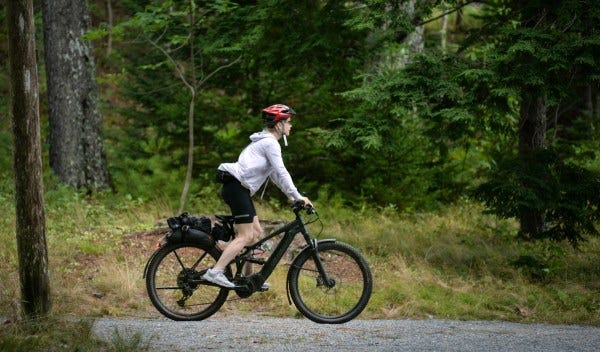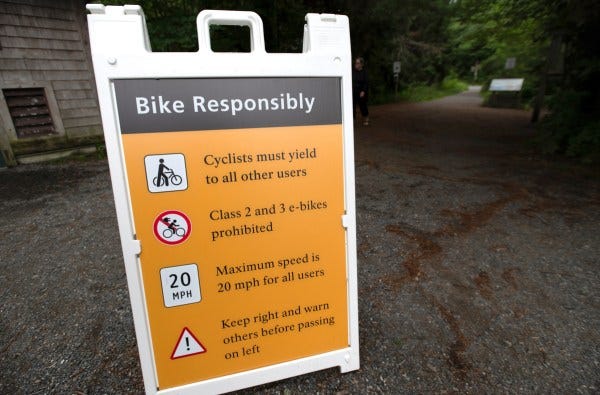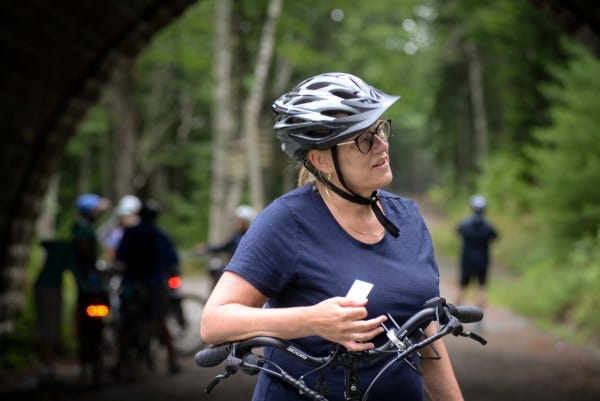by Bill Trotter/Bangor Daily News
MOUNT DESERT ISLAND—Over the last five years, one activity has clearly established itself as the favorite new thing for tourists to do in Acadia National Park.
There was zero electric bike traffic on the park’s scenic carriage roads five years ago, but e-bikes now make up roughly half of all bicycle traffic on the restricted gravel paths, according to a park official.

For years, some conservation groups had opposed allowing e-bikes to go places in national parks where motorized vehicles could not, arguing that the harmful impacts would be too great. E-bike advocates countered that allowing them would make national parks more accessible to those with certain physical limitations.
Now, the soaring popularity of e-bikes in Acadia indicates that many park visitors see them as more of a boon than a bust.
“It definitely makes riding more enjoyable,” said Debbie Tuel of Charlestown, Massachusetts, who was riding rented e-bikes with her husband in the park last week.
The couple, with their dog Reese riding in a pack on Tuel’s back, were among dozens of cyclists—both traditional and e-bike—who pedaled through a busy intersection of carriage roads during a recent sunny morning at the north end of Eagle Lake.
Amanda Pollock, spokesperson for Acadia, said the park has been studying and learning more about e-bikes since the National Park Service decided in 2019 that it must allow them wherever regular bicycles could go.

At the time, the park decided to lower the carriage road speed limit for all cyclists from 25 to 20 mph and to allow only Class 1 e-bikes on them. Class 1 e-bikes have a top speed of 20 mph and require riders to pedal to get a boost from the electric motor.
The two higher classes of e-bike are only allowed on the park’s paved roads, along with other motorized vehicles. They’re Class 2 e-bikes, which do not require pedaling to get a motorized boost, and Class 3, which can exceed 20 mph.
Since 2019, park staff and students at Worcester Polytechnic Institute have been collecting data on e-bike usage, but so far, no additional rules have been implemented or amended, Pollock said.
“Though the amount of total bike traffic has not changed substantially since 2019, about half of that traffic this past year was on e-bikes,” she said.
Pollock said there have long been occasional user conflicts and complaints on the carriage roads, which also are used by hikers, horseback riders, and horse-drawn carriages. Those complaints predate the use of e-bikes, however, and don’t appear to involve one type of cycling more than the other, she said.
Glenn Tucker, owner of Acadia Outfitters in Bar Harbor, said he sees a usage difference in the two types of bicycles at his business. Regular bikes still make up the larger volume of his rentals—around 60 or 65 percent, he said—with e-bikes getting a smaller share. But his e-bike rental business is growing.
“That ratio changes a little bit every year,” Tucker said.

Tucker charges more for e-bike rentals because they’re more expensive to acquire and slightly more complicated to maintain than a regular bike. He said he won’t rent an e-bike to anyone under the age of 16, and won’t let anyone younger than 18 rent one without an adult present.
As a result, families with young children make up most of his regular bike customer base, he said, and older people make up most of his e-bike customers.
“It’s almost like two different markets,” he said.
Regular bike users can use a shuttle operated by the free Island Explorer bus system to get their rides trailered from downtown Bar Harbor, where many rental shops are located, to the carriage roads by Eagle Lake.
However, like most transit systems, Island Explorer won’t transport e-bikes because they are substantially heavier and pose too many logistical issues for loading onto trailers, according to an Island Explorer official.

But what makes e-bikes heavy — the motor and battery — also makes it easier for riders to make their way uphill from downtown Bar Harbor to the nearby park entrances, according to Tucker. He said many of his customers have never ridden e-bikes before.
“You can hear them shouting ‘woo-hoo!’ as they glide uphill toward the park,” he said. “They like the boost they get.”
Matt Tuel, Debbie Tuel’s husband, had previous e-bike experience before coming to Acadia last week. He projected that, with the help of the motorized boost they would get from pedaling, they would cover 20 miles of Acadia’s carriage roads that afternoon.
“I feel like I get a workout still but travel twice as far” than on a regular bike, he said.
Helen LaRochelle, of Levis, Quebec, said using a regular bike for her is not an option. She said she brought her e-bike to Acadia from home because she has a neurological issue that limits her muscle power.

Without her e-bike, she wouldn’t be able to get far along the carriage roads, she said.
“It’s very good for people with mobility problems,” LaRochelle said. “It’s magical, because I can do something with my husband.”
This story appears through a media partnership with the Bangor Daily News.
That just means that sometimes they use our stories and sometimes we use theirs—all with permission.
If you’d like to donate to help support us, you can, but no pressure! Just click here.





"It definitely makes riding more enjoyable,”
And that says it all. Riding. Not cycling.
And E-bikes do not make the carriage trails more enjoyable for cyclists and pedestrians.
Many E-bike riders on the carriage trails are as heedless of cyclists and pedestrians, as the drivers of other motor vehicles are on the roads.
Today we live in a "herd" culture where "the more the merrier" is the keynote slogan. That said there still remains a substantial number of Americans who enjoy getting away from the crowds and enjoying the solace of solitude in nature. It was for these people that areas of the country were set aside as National Parks. If memory serves it was also the primary driver of the creation of Acadia National Park by George Dorr and John D Rockefeller. Both Dorr and Rockefeller were both on record as being opposed to the use of motorized vehicles on the carriage trails. While E-bikes are not powered by gasoline engines (thank God) they are most certainly "motorized". My guess is given Rockefeller's vast holdings in the petroleum industry he'd be even more opposed to electric bikes than those powered by gasoline. Years ago while driving across Canada on the Trans Canadian Highway I happened to stumble across a Canadian radio program discussing the growing problem of overcrowded Canadian National Parks. One of the participants made a statement that I felt pretty much summed up the situation. This is what he said, "The vast majority of people traveling to National Parks today are not truly nature lovers. Rather they are largely people fleeing the beehive activity of large citizens and overcrowded suburbs. They are just looking for a place to park their RV or set up their tent so they can play badminton and barbecue some steaks or hotdogs." The simple solution, he felt, was to build large urban campgrounds outside major cities to which these people could travel during their vacations. Although E-Bikes didn't exist at the time I do not doubt that he would have been willing to include some E-Bike trails in and around the parking lots. Those willing to travel under their own power would thus be free to enjoy far less crowded National Parks where nature untrammeled would be theirs to enjoy